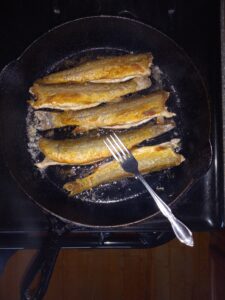The Green Drake Hatch

Matt LaRoche
The green drake is one of the most geographically widespread mayflies in North America and an important part of the food chain in clean unspoiled lakes and ponds.
Have you ever been on a wild brook trout pond during the green drake hatch? If so, you are probably still talking about it! Every year about the first week of July, these giant mayflies hatch on most of Maine’s trout ponds.
Hexagenia limbata (hex) or green drakes as we call them in the Maine woods are a favorite food source for most species of fish. Brook trout are especially fond of these insects and feed heavily on them during the hatch.
The Green Drake
The green drake is one of the most geographically widespread mayflies in North America and an important part of the food chain in clean unspoiled lakes and ponds.
The lifecycle of the green drake lasts about two years on Maine trout ponds. The nymph leaves its burrow in the bottom of the pond at about dusk and swims to the surface of the pond where it sheds the exoskeleton. The fully winged sub imago (also called a dun) emerge from the exoskeleton and take flight in only a few minutes. During the night or the next day male and female duns molt a final time. At dusk, female duns fly into a swam of males. The males and females mate in flight during darkness. Shortly after mating the female settles down on the surface of the pond, extrudes her eggs (as many as 8000) and dies – this is called the spinner fall. The eggs sink to the lake bottom, tiny nymphs hatch after several days. The nymphs burrow into the lake bottom and feed on plankton. The nymph enlarges its burrow as it grows; the burrows of mature nymphs can be up to five inches deep.
When fishing the green drake hatch, the best fishing is usually from dusk until you can’t see anymore. I have been on ponds that have a good hex hatch in the late afternoon and had to work hard with a sinking line and nymph imitation to catch only one or two brookies. Then all of a sudden at dusk, a few duns hatch and the fishing turns from slow to fantastic in just a few minutes. Fish start rising everywhere!
The flies are especially vulnerable at the surface of the pond when they are shedding their exoskeleton. As they struggle to emerge and dry off their wings, they are easy prey for a hungry brook trout.
The Cast
All you usually need to do is cast a fly that looks about the right size and color over a rising fish, give it a twitch and you will hook a fish.
If there is a good hatch and you don’t see many fish rising – that is a good pretty good sign that the population of trout in that pond is low.
Most of the muddy bottom trout ponds in Maine’s Northwoods have a good hex hatch. Just ask for advice at a local sporting goods store or hire a Maine guide to take you out on a remote trout pond to fish the famous green drake hatch.
Matt LaRoche is the retired superintendent of the Allagash Wilderness Waterway, an avid outdoorsman and the owner of Maine Woods Guide Service. He can be reached at [email protected] or call at 207-695-2877.See www.mainewoodsguide.com
For more articles about hunting, fishing and the great outdoors, be sure to subscribe to the
